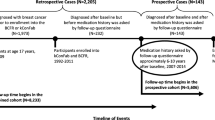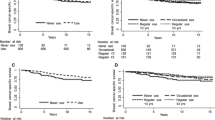Abstract
Objective
Chronic inflammation is suspected to have a role in breast carcinogenesis. Results of studies of non-steroidal anti-inflammatory drugs (NSAIDs) and breast cancer have been inconsistent. Timing of exposure and analysis of individual NSAIDs should be considered.
Methods
We conducted a population-based case–control study in western New York State between 1996 and 2001. Cases, 35–79 years, had incident, primary, histologically confirmed breast cancer (n = 1,170). Controls (n = 2,115) were randomly selected from NY Department of Motor Vehicles records (<65 years) or Medicare rolls (≥65 years). Participants were queried on use of aspirin, ibuprofen, and acetaminophen in the year prior and on aspirin during adulthood. Unconditional logistic regression was used to estimate adjusted odds ratios (OR) and 95% confidence intervals (95% CI).
Results
Recent aspirin use was inversely associated with breast cancer risk (adjusted OR 0.80, 95% CI: 0.68–0.94); the strongest reduction in risk was observed among those who took ≥2 pills/day on days that aspirin was taken (OR 0.74, 95% CI: 0.61–0. 90). Adult lifetime use was also associated with breast cancer risk (>10 days/month, adjusted OR 0.68, 95% CI: 0.46–1.00). Use of ibuprofen or acetaminophen was not associated with breast cancer.
Conclusions
This is the first study to investigate the association of adult lifetime aspirin intake with breast cancer risk. Our findings provide evidence that aspirin use throughout a woman’s life may confer some benefit.
Similar content being viewed by others
References
Coussens LM, Werb Z (2002) Inflammation and cancer. Nature 420(6917):860–867
Harris RE, Beebe-Donk J, Doss H, Burr-Doss D (2005) Aspirin, ibuprofen and other non-steroidal anti-inflammatory drugs in cancer prevention: a critical review of non-selective COX-2 blockade. Oncol Rep 13:559–583
Singh-Ranger G, Mokbel K (2002) The role of cyclooxygenase-2 (COX-2) in breast cancer, and implications of COX-2 inhibition. Eur J Surg Oncol 28(7):729–737
Brueggemeier RW, Diaz-Cruz ES, Li P-K, Sugimoto Y, Lin YC, Shapiro CL (2005) Translational studies on aromatase, cyclooxygenases, and enzyme inhibitors in breast cancer. J Steroid Biochem Mol Biol 95(1–5):129–136
Coogan PF, Rao SR, Rosenberg L, Palmer JR, Strom BL, Zauber AG, Stolley PD, Shapiro S (1999) The relationship of nonsteroidal anti-inflammatory drug use to the risk of breast cancer. Prev Med 29(2):72–76
Harris RE, Namboodiri K, Stellman SD, Wynder EL (1995) Breast cancer and NSAID use: heterogeneity of effect in a case-control study. Prev Med 24(2):119–120
Harris RE, Namboodiri KK, Farrar WB (1996) Nonsteroidal antiinflammatory drugs and breast cancer. Epidemiology 7(2):203–205
Sharpe CR, Collet JP, McNutt M, Belzile E, Boivin JF, Hanley JA (2000) Nested case-control study of the effects of non-steroidal anti-inflammatory drugs on breast cancer risk and stage. Br J Cancer 83(1):112–120
Cotterchio M, Kreiger N, Sloan M, Steingart A (2001) Nonsteroidal anti-inflammatory drug use and breast cancer risk. Cancer Epidemiol Biomarkers Prev 10(11):1213–1217
Meier CR, Schmitz S, Jick H (2002) Association between acetaminophen or nonsteroidal antiinflammatory drugs and risk of developing ovarian, breast, or colon cancer. Pharmacotherapy 22(3):303–309
Moorman PG, Grubber JM, Millikan RC, Newman B (2003) Association between non-steroidal anti-inflammatory drugs (NSAIDs) and invasive breast cancer and carcinoma in situ of the breast. Cancer Causes Control 14(10):915–922
Garcia Rodriguez LA, Gonzalez-Perez A (2004) Risk of breast cancer among users of aspirin and other anti-inflammatory drugs. Br J Cancer 91(3):525–529
Terry MB, Gammon MD, Zhang FF, Tawfik H, Teitelbaum SL, Britton JA, Subbaramaiah K, Dannenberg AJ, Neugut AI (2004) Association of frequency and duration of aspirin use and hormone receptor status with breast cancer risk. JAMA 291(20):2433–2440
Rahme E, Ghosn J, Dasgupta K, Rajan R, Hudson M (2005) Association between frequent use of nonsteroidal anti-inflammatory drugs and breast cancer. BMC Cancer 5:159
Swede H, Mirand AL, Menezes RJ, Moysich KB (2005) Association of regular aspirin use and breast cancer risk. Oncology 68(1):40–47
Zhang Y, Coogan PF, Palmer JR, Strom BL, Rosenberg L (2005) Use of nonsteroidal antiinflammatory drugs and risk of breast cancer: the case–control surveillance study revisited. Am J Epidemiol 162(2):165–170
Harris RE, Beebe-Donk J, Alshafie GA (2006) Reduction in the risk of human breast cancer by selective cyclooxygenase-2 (COX-2) inhibitors. BMC Cancer 6:27
Egan KM, Stampfer MJ, Giovannucci E, Rosner BA, Colditz GA (1996) Prospective study of regular aspirin use and the risk of breast cancer. J Natl Canc Inst 88(14):988–993
Friis S, Sorensen HT, McLaughlin JK, Johnsen SP, Blot WJ, Olsen JH (2003) A population-based cohort study of the risk of colorectal and other cancers among users of low-dose aspirin. Br J Cancer 88:684–688
Harris RE, Chlebowski RT, Jackson RD, Frid DJ, Ascenseo JL, Anderson G, Loar A, Rodabough RJ, White E, McTiernan A, Women’s Health I (2003) Breast cancer and nonsteroidal anti-inflammatory drugs: prospective results from the Women’s Health Initiative. Cancer Res 63(18):6096–6101
Harris RE, Kasbari S, Farrar WB (1999) Prospective study of nonsteroidal anti-inflammatory drugs and breast cancer. Oncol Rep 6(1):71–73
Johnson TW, Anderson KE, Lazovich D, Folsom AR (2002) Association of aspirin and nonsteroidal anti-inflammatory drug use with breast cancer. Cancer Epidemiol Biomarkers Prev 11(12):1586–1591
Schreinemachers DM, Everson RB (1994) Aspirin use and lung, colon, and breast cancer incidence in a prospective study. Epidemiology 5(2):138–146
Sorensen HT, Friis S, Norgard B, Mellemkjaer L, Blot WJ, MacLaughlin JK, Ekbom A, Baron JA (2003) Risk of cancer in a large cohort of nonaspirin NSAID users: a population-based study. Br J Cancer 88(11):1687–1692
Friis S, Thomassen L, Sorensen HT, Tjonneland A, Overvad K, Cronin-Fenton DP, Vogel U, McLaughlin JK, Blot WJ, Olsen JH (2008) Nonsteroidal anti-inflammatory drug use and breast cancer risk: a Danish cohort study. Eur J Cancer Prev 17(2):88–96
Gallicchio L, Visvanathan K, Burke A, Hoffman SC, Helzlsouer KJ (2007) Nonsteroidal anti-inflammatory drugs and the risk of developing breast cancer in a population-based prospective cohort study in Washington County, MD. Int J Cancer 121(1):211–215
Gierach GL, Lacey JV Jr, Schatzkin A, Leitzmann MF, Richesson D, Hollenbeck AR, Brinton LA (2008) Nonsteroidal anti-inflammatory drugs and breast cancer risk in the National Institutes of Health-AARP diet and health study. Breast Cancer Res 10(2):R38
Gill J, Maskarinec G, Wilkens LR, Pike MC, Henderson BE, Kolonel LN (2007) Nonsteroidal antiinflammatory drugs and breast cancer risk: the multiethnic cohort. Am J Epidemiol 166(10):1150–1158
Jacobs EJ, Thun MJ, Bain EB, Rodriguez C, Henley SJ, Calle EE (2007) A large cohort study of long-term daily use of adult-strength aspirin and cancer incidence. J Natl Canc Inst 99(8):608–615
Jacobs EJ, Thun MJ, Connell CJ, Rodriguez C, Henley SJ, Feigelson HS, Patel AV, Flanders WD, Calle EE (2005) Aspirin and other nonsteroidal anti-inflammatory drugs and breast cancer incidence in a large US cohort. Cancer Epidemiol Biomarkers Prev 14(1):261–264
Marshall SF, Bernstein L, Anton-Culver H, Deapen D, Horn-Ross PL, Mohrenweiser H, Peel D, Pinder R, Purdie DM, Reynolds P, Stram D, West D, Wright WE, Ziogas A, Ross RK (2005) Nonsteroidal anti-inflammatory drug use and breast cancer risk by stage and hormone receptor status. J Natl Cancer Inst 97(11):805–812
Eliassen AH, Chen WY, Spriegelman D, Willet WC, Hunter DJ, Hankinson SE (2009) Use of aspirin, other nonsteroidal anti-inflammatory drugs, and acetaminophen and risk of breast cancer among premenopausal women in the nurses’ health study II. Arch Intern Med 169(2):115–121
Ready A, Velicer CM, McTiernan A, White E (2008) NSAID use and breast cancer risk in the VITAL cohort. Breast Cancer Res Treat 109:533–543
Takkouche B, Regueira-Mendez C, Etminan M (2008) Breast cancer and use of nonsteroidal anti-inflammatory drugs: a meta-analysis. J Natl Cancer Inst 100(20):1420–1423
Cook NR, Lee IM, Gaziano JM, Gordon D, Ridker PM, Manson JE, Hennekens CH, Buring JE (2005) Low-dose aspirin in the primary prevention of cancer: the Women’s Health Study: a randomized controlled trial. J Am Med Assoc 294(1):47–55
Burke A, Smyth E, FitzGerald GA (2006) Analgesic-antipyretic agents; pharmacotherapy of Gout. In: Brunton LL, Lazlo JS, Parker KL (eds) Goodman & Gilman’s the pharmacological basis of therapeutics, 11th edn. McGraw-Hill, New York, pp 671–716
Bonner MR, Han D, Nie J, Rogerson P, Vena JE, Muti P, Trevisan M, Edge SB, Freudenheim JL (2005) Breast cancer risk and exposure in early life to polycyclic aromatic hydrocarbons using total suspended particulates as a proxy measure. Cancer Epidemiol Biomarkers Prev 14(1):53–60
Bonner MR, Nie J, Han D, Vena JE, Rogerson P, Muti P, Trevisan M, Edge SB, Freudenheim JL (2005) Secondhand smoke exposure in early life and the risk of breast cancer among never smokers (United States). Cancer Causes Control 16(6):683–689
McCann SE, Ip C, Ip MM, McGuire MK, Muti P, Edge SB, Trevisan M, Freudenheim JL (2004) Dietary intake of conjugated linoleic acids and risk of premenopausal and postmenopausal breast cancer, Western New York Exposures and Breast Cancer Study (WEB Study). Cancer Epidemiol Biomarkers Prev 13(9):1480–1484
Han D, Nie J, Bonner MR, McCann SE, Muti P, Trevisan M, Ramirez-Marrero FA, Vito D, Freudenheim JL (2006) Lifetime adult weight gain, central adiposity, and the risk of pre- and postmenopausal breast cancer in the Western New York exposures and breast cancer study. Int J Cancer 119(12):2931–2937
Hersh EV, Moore PA, Ross GL (2000) Over-the-counter analgesics and antipyretics: a critical assessment. Clinical Therapeutics 22(5):500–548
O’Brien SN, Anandjiwala J, Price TM (1997) Differences in the estrogen content of breast adipose tissue in women by menopausal status and hormone use. Obstet Gynecol 90(2):244–248
Lieber CS (2004) Alcoholic fatty liver: its pathogenesis and mechanism of progression to inflammation and fibrosis. Alcohol 34(1):9–19
Davies G, Martin LA, Sacks N, Dowsett M (2002) Cyclooxygenase-2 (COX-2), aromatase and breast cancer: a possible role for COX-2 inhibitors in breast cancer chemoprevention. Ann Oncol 13(5):669–678
Howe LR, Chang S-H, Tolle KC, Dillon R, Young LJT, Cardiff RD, Newman RA, Yang P, Thaler HT, Muller WJ, Hudis C, Brown AMC, Hla T, Subbaramaiah K, Dannenberg AJ (2005) HER2/neu-induced mammary tumorigenesis and angiogenesis are reduced in cyclooxygenase-2 knockout mice. Cancer Res 65(21):10113–10119
Karmali RA, Marsh J, Fuchs C (1984) Effect of omega-3 fatty acids on growth of a rat mammary tumor. J Natl Cancer Inst 73(2):457–461
Kort WJ, Weijma IM, Bijma AM, van Schalkwijk WP, Vergroesen AJ, Westbroek DL (1987) Omega-3 fatty acids inhibiting the growth of a transplantable rat mammary adenocarcinoma. J Natl Cancer Inst 79(3):593–599
Liu CH, Chang SH, Narko K, Trifan OC, Wu MT, Smith E, Haudenschild C, Lane TF, Hla T (2001) Overexpression of cyclooxygenase-2 is sufficient to induce tumorigenesis in transgenic mice. J Biol Chem 276(21):18563–18569
Shiff SJ, Rigas B. (1999) The role of cyclooxygenase inhibition in the antineoplastic effects of nonsteroidal antiinflammatory drugs (NSAIDs). J Exp Med 190(4):445–450
Acknowledgments
This work was supported in part by grants DAMD-17-03-1-0446 and DAMD-17-96-1-6202 from the US Department of Defense, and NCI RO1CA92040, P50-AA09802, and R25-CA94880 from the National Institutes of Health, National Cancer Institute.
Author information
Authors and Affiliations
Corresponding author
Rights and permissions
About this article
Cite this article
Brasky, T.M., Bonner, M.R., Moysich, K.B. et al. Non-steroidal anti-inflammatory drug (NSAID) use and breast cancer risk in the Western New York Exposures and Breast Cancer (WEB) Study. Cancer Causes Control 21, 1503–1512 (2010). https://doi.org/10.1007/s10552-010-9579-5
Received:
Accepted:
Published:
Issue Date:
DOI: https://doi.org/10.1007/s10552-010-9579-5




